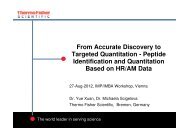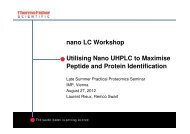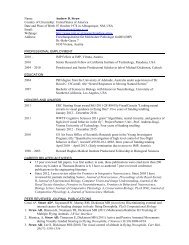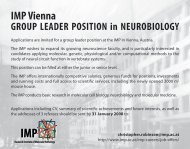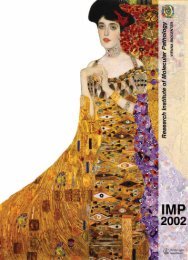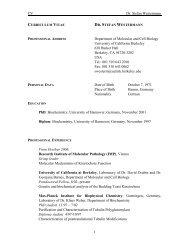Alexander MAKAROV - IMP
Alexander MAKAROV - IMP
Alexander MAKAROV - IMP
You also want an ePaper? Increase the reach of your titles
YUMPU automatically turns print PDFs into web optimized ePapers that Google loves.
Late Summer Proteomics<br />
Seminar at <strong>IMP</strong> Vienna<br />
Orbitrap Mass Spectrometry<br />
for Quantitative Analysis<br />
A.Makarov<br />
August 27, 2012
There are different views on this world…<br />
Life<br />
Genomics<br />
…-omics<br />
Proteomics<br />
C.Flammarion (1842—1925)<br />
Instrumentomics<br />
2<br />
http://commons.wikimedia.org/wiki/File:THE_TURTLE_AND_ELEPHANT.jpg
Mass spectrometry for discovery proteomics<br />
Magnetic<br />
sectors<br />
Res. power<br />
Transmission<br />
Mass accuracy<br />
Dynamic range<br />
Speed<br />
Quantitation<br />
All-ion detection<br />
Simplicity<br />
Time-of-flight (oa)<br />
FT ICR<br />
Ion traps<br />
Res. power<br />
Transmission<br />
Mass accuracy<br />
Dynamic range<br />
Speed<br />
Quantitation<br />
All-ion detection<br />
Simplicity<br />
Quadrupoles<br />
3<br />
Res. power<br />
Transmission<br />
Mass accuracy<br />
Dynamic range<br />
Speed<br />
Quantitation<br />
All-ion detection<br />
Simplicity<br />
Trapping<br />
Use of shaped electrodes<br />
Image current detection<br />
Pulsed injection<br />
Electrostatic fields
What is Orbitrap analyzer?<br />
Orbitrap analyzer =<br />
= Orbital<br />
trapping<br />
+ Image current<br />
detection<br />
+ Electrodynamic<br />
squeezing<br />
+ External pulsed<br />
ion source<br />
4
Orbital trapping<br />
“Ideal Kingdon trap”:<br />
Quadro-logarithmic potential<br />
U ( r,<br />
z)<br />
=<br />
k<br />
⋅<br />
2<br />
2 2 2<br />
{ z − r / 2 + R ⋅ln(<br />
r / )}<br />
m<br />
R m<br />
Characteristic frequencies:<br />
• Frequency of rotation ω φ<br />
• Frequency of radial oscillations ω r<br />
• Frequency of axial oscillations ω z<br />
ω ϕ<br />
=<br />
ω z<br />
2<br />
⎛<br />
⎜<br />
⎝<br />
R m<br />
R<br />
2<br />
⎞<br />
⎟<br />
⎠<br />
−1<br />
ω r<br />
= ω z<br />
ω<br />
z<br />
=<br />
⎛<br />
⎜<br />
⎝<br />
R m<br />
R<br />
k<br />
m / q<br />
2<br />
⎞<br />
⎟<br />
⎠<br />
−<br />
2<br />
“Beauty will save the world.”- F.M. Dostoevsky<br />
5<br />
Trapping and quantitation?<br />
Only this frequency does not<br />
depend on energy, angle, etc.<br />
and is used for mass analysis
Detection of Ions in the Orbitrap analyzer<br />
• Frequency of axial oscillations of each ring induces an image current on<br />
split outer electrodes<br />
• Multiple ions in the Orbitrap generate a complex signal with frequencies<br />
determined using a Fourier Transformation<br />
Image current detection<br />
•All-mass detection<br />
•Noise equivalent to
Injection of Ions into the Orbitrap analyzer<br />
• A short ion packet of one m/z<br />
enters the field<br />
• Increasing voltage squeezes<br />
ions<br />
• “Excitation by injection” is<br />
initiated<br />
• Voltage stabilises and ion<br />
trajectories are also stabilized<br />
• Angular spreading forms<br />
ROTATING RINGs bouncing<br />
back and forth<br />
7<br />
I(t)<br />
“Built-in” excitation is<br />
independent of trapping,<br />
hence no limit on linearity
Proof of Principle: Orbitrap with Laser Ion Source<br />
Field compensator<br />
Ion source<br />
0.8 sec<br />
High voltage<br />
amplifier<br />
8 M record length<br />
10 Ms/s (borrowed<br />
LeCroy)<br />
0.8 s transient<br />
f =711 kHz,∆f=2.39 Hz<br />
f/∆f≈ 300000<br />
M/∆M=½ f/∆f ≈ 150000<br />
8<br />
A.A. Makarov, Anal. Chem., v.72 (2000), No.6, p.1156-1162.
Injection of Ions into the Orbitrap analyzer<br />
Lenses<br />
Deflector<br />
C-trap<br />
• Ions are stored and<br />
cooled in a curved RFonly<br />
quadrupole (Ctrap)<br />
• RF is ramped down,<br />
radial DC is applied<br />
• Ions are ejected along<br />
lines converging on the<br />
orbitrap entrance).<br />
• As ions enter orbitrap,<br />
they are picked up and<br />
squeezed by its<br />
electric field<br />
• All ions start simultaneously,<br />
but light<br />
ions enter Orbitrap<br />
analyzer earlier that<br />
heavy ions<br />
9<br />
I(t)<br />
Double trappingand<br />
quantitation?
Could a trapping device be used for quantitation?<br />
Quantitation requires: What a trap needs: Missing:<br />
•High linearity<br />
(signal/input)<br />
•Precise control over<br />
input-dependent effects<br />
(i.e. space-charge effects)<br />
•Linear detection system<br />
Automatic gain<br />
control (AGC),<br />
corrections<br />
•High discriminating<br />
power<br />
•High dynamic range<br />
•High resolution<br />
•High mass accuracy<br />
•High ion capacity<br />
•Concept of “charge budget”<br />
AGC<br />
Intelligent filling<br />
•Low limits of<br />
quantitation (LOQ)<br />
•High transmission<br />
•High sensitivity of<br />
detection<br />
•(UHP)LC-compatible<br />
speed of analysis<br />
10<br />
Help is needed!<br />
•Fast/ultra-fast acquisition<br />
Detectionindep.<br />
filling
Instrumentomics in action: Orbitrap hybrid No. 1<br />
Detect<br />
speed<br />
“Instrument<br />
polymerase”<br />
Speed<br />
of<br />
isolation<br />
Thermo Scientific LTQ Orbitrap LC-MS n<br />
11<br />
Image from:<br />
http://commons.wikimedia.org/w/index.php?title=File:DNA_Repair.jpg&oldid=45779464
LTQ-Orbitrap: All Technologies Come Together<br />
1. Ions are stored in the linear trap of LTQ<br />
2. …are axially ejected<br />
3. …and trapped in the C-trap and<br />
squeezed into a smaller cloud<br />
4. …then a voltage pulse across C-trap<br />
ejects ions towards the Orbitrap<br />
5. …where they are trapped and detected<br />
V<br />
Gas
LTQ Orbitrap for Absolute SILAC experiments<br />
Experiment requires:<br />
Resolving power &<br />
Mass accuracy &<br />
Dynamic Range &<br />
Parallel MS/MS &<br />
Scan Speed &<br />
Sensitivity<br />
Linearity of Quantitation of a Protein<br />
A<br />
Pure Form<br />
B<br />
Background of<br />
Total Cell Lysate<br />
S. Hanke, H. Besir, D. Oesterhelt, M. Mann<br />
J. Proteome Res. 2008, 7 (3), 1118–1130.<br />
0.5 fmol<br />
150 fmol<br />
45,000 fmol<br />
13
Orbitrap Elite instrument<br />
Dual trap<br />
up to 12<br />
scans/sec<br />
“Freedom of<br />
fragmentation”:<br />
CID, HCD, ETD<br />
ETD option<br />
Top-of-the-range<br />
RF-lens interface<br />
Compact high-field<br />
Orbitrap analyzer+ eFT:<br />
up to 8 scans/sec<br />
14
Reporter-based quantitation: MS n for gas-phase purification<br />
MS 1<br />
MS 2<br />
Full MS scan<br />
Precursor ion isolation at m/z p (z>1)<br />
CID in LT<br />
PTR in LT<br />
Isolation at m/z f >m/z p<br />
MS 3 Ting L, Rad R, Gygi SP, Haas W.<br />
HCD of m/z f<br />
(+ CID of precursor)<br />
Reporter ion quantitation<br />
15<br />
Nat Methods. 8 (11) (2011), p. 937-940.<br />
QuantMode<br />
Wenger CD, Lee MV, Hebert AS, McAlister<br />
GC, Phanstiel DH, Westphall MS, Coon JJ.<br />
Nat Methods. 8 (11) (2011), p. 933-935.
Instrumentomics in action:<br />
Orbitrap hybrid No.2<br />
Detect<br />
speed<br />
“Instrument<br />
polymerase”<br />
Speed<br />
of<br />
isolation<br />
16<br />
Thermo Scientific Q Exactive LC-MS/MS<br />
Image from:<br />
http://commons.wikimedia.org/w/index.php?title=File:DNA_Repair.jpg&oldid=45779464
Q Exactive: ultra-high resolution hybrid on bench-top<br />
• Quadrupole mass filter interfaced to a standard Orbitrap analyzer<br />
• Enhanced Fourier transform (eFT) for Orbitrap data processing<br />
• Parallel filling & detection<br />
• Possibility of multiple fills for spectrum multiplexing<br />
• Common with Orbitrap Velos Pro/Elite:<br />
• Predictive automatic gain control (pAGC: MS/MS on the basis of full MS scan)<br />
• S-lens for higher transmission (like in LTQ) with rugged optic<br />
• C-trap directly interfaced to HCD (like in LTQ Orbitrap Velos)<br />
17<br />
Michalski, A; Damoc, E; Hauschild, JP; Lange, O; Wieghaus, A; Makarov, A; Nagaraj, N; Cox, J;<br />
Mann, M; Horning, S. “Mass Spectrometry-based Proteomics Using Q Exactive, a High-performance<br />
Benchtop Quadrupole Orbitrap Mass Spectrometer”. Mol. Cell Proteomics 10, (2011)
Automatic gain control (AGC) in Orbitrap hybrids<br />
• Linear trap hybrids<br />
• Orbitrap Series: e.g. Elite, Velos Pro, ...<br />
• Two independent detectors (Linear Ion Trap + Orbitrap)<br />
• AGC for the Orbitrap is done via complementary detector<br />
• Inject time is accurately determined in all cases<br />
• Bench-Top systems<br />
• Exactive Series: Exactive, Q Exactive<br />
• Single detector (Orbitrap)<br />
• AGC is done via a prescan with reduced acquisition time<br />
(typ. 20ms)<br />
• Inject time is accurately determined in almost all cases<br />
An exception: The AGC-prescan contains mainly highly<br />
charged species and many peaks below the noise threshold<br />
18<br />
Poster: Th623<br />
Improved analysis of biopharmaceutical samples using an MS-only Orbitrap mass spectrometer<br />
O. Scheibner; E. Damoc; E. Denisov; J.-P. Hauschild; O. Lange; F. Czemper; A. Kholomeev, A. Makarov;<br />
A. Wieghaus; M. Bromirski
Example: HeLa run with incompletely digested proteins<br />
HeLa_LysC_noEM_1e6_1e5_mz350_2000_fm150HCD_1 #18610 RT: 61.67 AV: 1 NL: 4.62E4<br />
T: FTMS + p NSI Full ms [350.00-2000.00]<br />
Relative Abundance<br />
Relative Abundance<br />
100<br />
80<br />
60<br />
40<br />
20<br />
19<br />
0<br />
100<br />
80<br />
60<br />
40<br />
20<br />
0<br />
Relative Abundance<br />
100<br />
80<br />
60<br />
40<br />
20<br />
0<br />
497.00040<br />
R=36500<br />
z=?<br />
10 15 20 25 30 35 40 45 50 55 60 65 70<br />
Time (min)<br />
636.95868<br />
R=41204<br />
z=3<br />
19.43<br />
722.46362<br />
R=33202<br />
z=?<br />
19.47<br />
29.90<br />
29.59<br />
25.98 29.96<br />
28.32 31.79<br />
18.23<br />
22.59<br />
15.67 32.74<br />
13.23 37.11<br />
40.93<br />
34.07 42.77<br />
44.39 50.03<br />
Suspiciously empty end of elution…<br />
827.94812<br />
R=33700<br />
z=?<br />
921.32239<br />
R=31906<br />
z=6 1125.25989<br />
998.30304<br />
R=27506<br />
z=4<br />
R=26906<br />
z=6<br />
1294.64734<br />
R=23002<br />
z=?<br />
1350.11121<br />
R=25406<br />
z=5<br />
1381.47974<br />
R=24406<br />
z=4<br />
1549.78955<br />
R=21506<br />
z=6<br />
1697.28662<br />
R=14800<br />
z=?<br />
54.10 57.65 59.30 60.86 64.90 71.68<br />
55 60 65 70<br />
1824.30591<br />
R=16600<br />
z=?<br />
1977.32275<br />
R=19600<br />
z=?<br />
400 500 600 700 800 900 1000 1100 1200 1300 1400 1500 1600 1700 1800 1900 2000<br />
m/z<br />
HeLa_LysC_noEM_1e6_1e5_mz350_2000_fm150HCD_1 #19027-19394 RT: 65.00-68.00 AV: 293 NL: 4.71E3<br />
T: FTMS + p NSI Full ms [350.00-2000.00]<br />
946.55941<br />
R=33317<br />
z=3<br />
445.12314<br />
R=51912<br />
z=?<br />
615.96752<br />
R=32939<br />
z=1<br />
713.40758<br />
R=37751<br />
z=?<br />
912.85357<br />
R=34397<br />
z=3<br />
1034.52732<br />
R=31884<br />
z=3<br />
1101.56294<br />
R=30690<br />
z=5<br />
1318.66850<br />
R=19466<br />
z=1<br />
1481.74376<br />
R=16917<br />
z=1<br />
1 spectrum<br />
1542.77453<br />
R=26371<br />
z=2<br />
1693.91682<br />
R=20607<br />
z=?<br />
400 500 600 700 800 900 1000 1100 1200 1300 1400 1500 1600 1700 1800 1900 2000<br />
m/z<br />
54.33<br />
55.27<br />
57.65<br />
57.69<br />
1866.41480<br />
R=24006<br />
z=6<br />
59.56<br />
60.30<br />
60.86<br />
1976.16243<br />
R=14206<br />
z=1<br />
x25<br />
64.90 67.76<br />
71.68<br />
71.78<br />
NL: 1.82E9<br />
Base Peak F: ms<br />
MS<br />
HeLa_LysC_noEM<br />
_1e6_1e5_mz350_<br />
2000_fm150HCD_<br />
1<br />
Σ
C-Trap Charge Detection (CTCD)<br />
TIC CTCD : every 5-10 sec<br />
TIC CTCD /TIC Orbitrap is used to<br />
adjust the inject time, if needed<br />
TIC Orbitrap<br />
20<br />
I(t)
Removal of signal suppression by C-Trap Charge Detection<br />
Relative Abundance<br />
4<br />
3<br />
2<br />
1<br />
0<br />
Relative Abundance<br />
100<br />
80<br />
60<br />
40<br />
20<br />
0<br />
p [ ]<br />
497.00040<br />
R=36500<br />
z=?<br />
636.95868<br />
R=41204<br />
z=3<br />
722.46362<br />
R=33202<br />
z=?<br />
827.94812<br />
R=33700<br />
z=?<br />
921.32239<br />
R=31906<br />
z=6 1125.25989<br />
998.30304<br />
R=27506<br />
z=4<br />
R=26906<br />
z=6<br />
1294.64734<br />
R=23002<br />
z=?<br />
1350.11121<br />
R=25406<br />
z=5<br />
1381.47974<br />
R=24406<br />
z=4<br />
1549.78955<br />
R=21506<br />
z=6<br />
400 500 600 700 800 900 1000 1100 1200 1300 1400 1500 1600 1700 1800 1900 2000<br />
m/z<br />
50.93<br />
54.33<br />
10 15 20 25 30 35 40 45 50 55 60 65 70<br />
55.27<br />
1697.28662<br />
R=14800<br />
z=?<br />
57.65<br />
57.69<br />
59.56<br />
NL=4.6e4<br />
1824.30591<br />
R=16600<br />
z=?<br />
60.30<br />
60.86<br />
1977.32275<br />
R=19600<br />
z=?<br />
64.90 67.76<br />
71.68<br />
CTCD<br />
OFF<br />
NL: 1.82E9<br />
Base Peak F: ms<br />
MS<br />
HeLa_LysC_noEM<br />
_1e6_1e5_mz350_<br />
2000_fm150HCD_<br />
1<br />
Relative Abundance<br />
4<br />
3<br />
2<br />
1<br />
53.96<br />
58.94<br />
54.38<br />
59.36<br />
62.14<br />
70.36<br />
70.33<br />
62.28 66.97<br />
64.10<br />
NL: 1.53E9<br />
Base Peak F: ms<br />
MS<br />
hela_lysc_wem_3e<br />
6_1e5_mz350_20<br />
00_fm150hcd_1<br />
0<br />
21<br />
10 15 20 25 30 35 40 45 50 55 60 65 70<br />
445.11856 536.16394<br />
Time (min)<br />
R=52407 R=47707<br />
z=1 z=1<br />
Relative Abundance<br />
100<br />
80<br />
60<br />
40<br />
20<br />
0<br />
674.55774<br />
R=39206<br />
z=5<br />
825.46289<br />
R=36104<br />
z=3<br />
950.84613<br />
R=32206<br />
z=3<br />
1056.53552<br />
R=31307<br />
z=2<br />
1191.24426<br />
R=28006<br />
z=3 1322.64648 1478.22644 1577.42529 1694.47510 1826.72253<br />
R=22204 R=20002 R=19902 R=18700 R=20702<br />
z=2<br />
z=? z=? z=? z=?<br />
NL=2.7e6<br />
1972.63916<br />
R=16902<br />
z=?<br />
400 500 600 700 800 900 1000 1100 1200 1300 1400 1500 1600 1700 1800 1900 2000<br />
m/z<br />
CTCD<br />
ON
Spectral acquisition speed with predictive AGC and<br />
parallel filling/detection<br />
AGC<br />
Orbitrap acquisition<br />
Orbitrap acquisition<br />
Orbitrap acquisition<br />
Inject to C-trap<br />
Inject to C-trap<br />
Inject to C-trap<br />
14<br />
12<br />
90%<br />
80%<br />
Scan speed does<br />
not change until fill<br />
time reaches 50 ms<br />
Resolving power<br />
setting: 17,500<br />
(fastest rate)<br />
At higher R, ion<br />
fill times and<br />
duty cycles<br />
increase further!<br />
Scans per second, Hz<br />
10<br />
8<br />
6<br />
4<br />
2<br />
0<br />
70%<br />
60%<br />
50%<br />
40%<br />
30%<br />
20%<br />
10%<br />
0%<br />
Duty cycle of ion filling, %<br />
Scan speed<br />
Duty cycle<br />
Up to 65% of the<br />
total time could be<br />
spent meanwhile on<br />
accumulating ions!<br />
0 20 40 60 80 100<br />
22<br />
Ion fill time, ms
Concept of “charge budget” in ion trap world<br />
• Any trapping device has a limit on the<br />
number of stored ions- “charge budget”<br />
• Typically, this budget is spent as a<br />
“blanket investment”, all peaks large and<br />
small accumulated for the same time. This<br />
limits dynamic range of analysis.<br />
• But the presence of a beam-type mass<br />
filter allows to break this rule and<br />
accumulate intelligently:<br />
• Peaks of interest only- in any desired<br />
combination<br />
• Enhancing certain m/z ranges by “focused<br />
investment”<br />
Q<br />
23
„Charge budget“ concept in targeted analysis<br />
• Sensitivity gain 5 – 10x with SIM<br />
mode<br />
• The gain will be higher in more<br />
complex matrices<br />
100<br />
80<br />
60<br />
40<br />
20<br />
0<br />
100<br />
80<br />
60<br />
40<br />
20<br />
195.0876<br />
N=248402.81<br />
195.0877<br />
N=20741.58<br />
Full MS<br />
S/N = 745<br />
IT= 0.245 ms<br />
SIM (10amu)<br />
For the same target:<br />
S/N = 5400<br />
IT= 1.321 ms<br />
NL: 1.94E8<br />
[150.00-2000.00]<br />
Lowest signal<br />
250330<br />
NL: 1.12E8<br />
[190.10-200.10]<br />
Lowest signal<br />
28240<br />
0<br />
Gain in sensitivity (7x)<br />
6000<br />
In Orbitrap instruments, SIM could<br />
become MRM without any<br />
noticeable time overhead!<br />
S/N (spectrum)<br />
5000<br />
4000<br />
3000<br />
2000<br />
1000<br />
Caffeine<br />
24<br />
0<br />
195.082 195.084 195.086 195.088 195.09 195.092 195.094<br />
S/N (FMS) S/N (SIM10)
Alprazolam quantitation experiment<br />
50 ppt – 10 ppb<br />
250 fg oc - 50 pg oc<br />
Full MS in matrix<br />
6000000<br />
5000000<br />
10 ppt – 10 ppb<br />
50 fg oc - 50 pg oc<br />
SIM<br />
Area<br />
4000000<br />
3000000<br />
2000000<br />
1000000<br />
0<br />
0 2000 4000 6000 8000 10000<br />
fg/uL<br />
Orbitrap 25 mass spectrometer”. Proc. 59th Conf. Amer. Soc. Mass Spectrom., Denver June 5-9, 2011.<br />
Zoom 10 ppt- 100ppt<br />
120000<br />
110000<br />
100000<br />
90000<br />
80000<br />
70000<br />
60000<br />
50000<br />
40000<br />
30000<br />
20000<br />
10000<br />
0<br />
0 20 40 60 80<br />
fg/uL<br />
100 120<br />
See also: X. He; M. Kozak. “Evaluation of quantitative performance for testosterone analysis in plasma on a novel quadrupole<br />
Area
48 Protein Experiment on Q Exactive<br />
• 204 identical peptides were targeted by three approaches:<br />
• Full scan MS,<br />
• Targeted SIM (t-SIM),<br />
• Targeted MS/MS (t-MS2) = t-SIM+ HCD (practically no time overhead)<br />
• Number of peptides quantifiable at respective spike concentration<br />
Total peptides quantified<br />
250<br />
#peptides quantified<br />
200<br />
150<br />
100<br />
50<br />
0<br />
1<br />
197 201 204 204 204<br />
164<br />
148<br />
137<br />
123<br />
106<br />
99<br />
35<br />
4 0<br />
0.5 5 12.5 25 >25<br />
Amount of spiked peptides [fmol/column]<br />
Full MS<br />
t-SIM<br />
t-MS2<br />
26<br />
t-MS2 method performs best
Minimum total number of ions needed for quantitation<br />
3000<br />
Min. number of ions for CV=10%<br />
2500<br />
2000<br />
1500<br />
1000<br />
500<br />
Qq-Q<br />
Qq-Orbi<br />
Qq-TOF<br />
.<br />
.<br />
.<br />
1<br />
2<br />
3<br />
N<br />
27<br />
0<br />
1 2 3 4 5 6 7 8 9 10<br />
Number of transitions in MRM<br />
CV=10% on the sum of fragment ion<br />
intensities<br />
Assumptions:<br />
• The same Qq for all<br />
• Transmission: 50% for Q3,<br />
30% for Orbitrap, 4% for TOF<br />
• Equal intensities of fragments<br />
• No interferences in QqQ…
Utilization of “Charge budget concept” using spectrum<br />
multiplexing<br />
Standard<br />
operation mode<br />
vs<br />
Spectrum<br />
multiplexing<br />
5.0x10 8<br />
4.5x10 8<br />
4.0x10 8<br />
3.5x10 8<br />
Ion count (arb.)<br />
3.0x10 8<br />
2.5x10 8<br />
2.0x10 8<br />
1.5x10 8<br />
1.0x10 8<br />
m/z195.08770<br />
m/z262.60000<br />
m/z393.20000<br />
m/z524.26500<br />
m/z1622.00000<br />
C-Trap storage: No ion loss<br />
over a broad range of<br />
storage times!<br />
(St.Steel, fused silica, ceramics)<br />
5.0x10 7<br />
28<br />
0.0<br />
1 10 100 1000<br />
Inject time [ms]
Low Attomole LOD, 4 Orders of Linear Dynamic Range<br />
Heavy-labeled peptides of eicosanoid pathway enzymes in 250 ng CSF digest.<br />
1E+09<br />
1E+09<br />
Peak Area<br />
100000000<br />
160000000<br />
10000000<br />
140000000 1000000<br />
100000<br />
120000000<br />
10000<br />
100000000<br />
1000<br />
1 10 100 1000 10000 100000<br />
80000000<br />
60000000<br />
40000000<br />
y = 1372.1x + 278774<br />
R² = 0.9998<br />
VAHTVAYLGK<br />
Peak area<br />
450000000<br />
400000000<br />
350000000<br />
300000000<br />
250000000<br />
200000000<br />
150000000<br />
100000000<br />
100000000<br />
10000000<br />
1000000<br />
100000<br />
10000<br />
1000<br />
1 10 100 1000 10000 100000<br />
y = 3820.1x + 578349<br />
R² = 0.9999<br />
YFQGYAR<br />
20000000<br />
50000000<br />
0<br />
0 20000 40000 60000 80000 100000 120000<br />
Sample amount (amole)<br />
0<br />
0 20000 40000 60000 80000 100000 120000<br />
Sample amount (amole)<br />
Protein Peptide LOQ (amole) LOD (amole)<br />
PTGDS GPGEDFR 25 8<br />
PTGS2 QFQYQNR 25 8<br />
PTGS1 LVLTVR 10 3<br />
HPGDS STLPFGK 25 8<br />
PTGES VAHTVAYLGK 30 10<br />
PTGIS FLNPDGSEK 50 17<br />
29<br />
TBXA1 SVADSVLFLR 100 33<br />
ALOX15 YTLEINVR 250 83<br />
ALOX12 LWEIIAR 500 167<br />
LTCS4 YFQGYAR 10 3<br />
Data courtesy Y. Xuan, M. Scigelova, ThermoFisher Scientific- Workshop 5
Data Independent Acquisition: why multiplexing?<br />
Classical data-independent acquisition (DIA )<br />
30<br />
• Lacks the specificity of DDA<br />
• 40 scans in this example to cover 400 amu
Data Independent Acquisition: multiplexing improves<br />
signal-to- noise<br />
Multiplexed DIA (msx-DIA )<br />
12 Hz Acquisition Rate<br />
60 Precursors / second<br />
Broad<br />
isolation<br />
5-plex injection<br />
Adding 5 x 4 amu<br />
isolation windows<br />
1s<br />
64ms detection<br />
1 6 11 16 21 26 31 36 41 46 51 56 …<br />
2 7 12 17 22 27 32 37 42 47 52 57 …<br />
3 8 13 18 23 28 33 38 43 48 53 58 …<br />
4 9 14 19 24 29 34 39 44 49 54 59 …<br />
5 10 15 20 25 30 35 40 45 50 55 60 …<br />
• 20 scans in this example to cover 400 amu<br />
msx-SIM:<br />
“great<br />
equalizer”<br />
m/z<br />
m/z<br />
31<br />
ASMS Poster ThP571: „Multiplexed Data Independent Acquisition for Comparative Proteomics.“<br />
Jarrett D. Egertson 1 ; Andreas Kuehn 2 ; Gennifer Merrihew 1 ; Nicholas Bateman 3 ; Brendan MacLean 1 ; Ying S.<br />
Ting 1 ; Jesse D. Canterbury 4 ; Markus Kellmann 2 ; Vlad Zabrouskov 4 ; Christine Wu 3 ; Michael J. MacCoss 1<br />
1<br />
University of Washington, Seattle, WA; 2 Thermo Fisher Scientific, Bremen, Germany; 3 University of<br />
Pittsburgh, Pittsburgh PA; 4 Thermo Fisher Scientific, San Jose, CA
Current and future uses of spectrum multiplexing<br />
Multiplexed SIMs/MRMs in a single Orbitrap<br />
spectrum<br />
Multiple fragmentation conditions in a single<br />
Orbitrap spectrum (e.g. HCD energy scan)<br />
• Selection of multiple charge states of the same<br />
precursor, each fragmented at optimum<br />
conditions, will increase sequence coverage<br />
• Combining several fragmentation techniques<br />
for the same precursor<br />
• Segmenting mass range of full MS (inc. datadependent)<br />
• ……<br />
De-couple<br />
LC from MS,<br />
better LOQs<br />
↑ quality of<br />
spectra and<br />
ID rate<br />
without<br />
increase of<br />
data files<br />
↑ dynamic<br />
range<br />
32
Conclusion<br />
• Ultra-high resolution<br />
• MS/MS sensitivity<br />
• Quantitation<br />
• Throughput<br />
33<br />
• Advances in technology continue to make quantitative Orbitrap mass spectrometry<br />
increasingly more sensitive and accurate<br />
• For peptide quantitation, Orbitrap mass spectrometry is the best technical solution<br />
• Further improvements of quantitation will be directed along directions of:<br />
• Better selectivity of precursors<br />
• Improvements of ion population control and of corresponding corrections<br />
• Higher spectral acquisition speed<br />
• Further development of spectra multiplexing
Acknowledgements<br />
34<br />
S. Horning<br />
T. Moehring<br />
E. Denisov<br />
A. Kholomeev<br />
A. Wieghaus<br />
W. Balschun<br />
O. Lange<br />
O. Hengelbrock<br />
K. Strupat<br />
S. Moehring<br />
J. Griep-Raming<br />
U. Froehlich<br />
D. Nolting<br />
F. Czemper<br />
R. Malek<br />
A. Kuehn<br />
T. Rietpietsch<br />
R. Malek<br />
M. Kellmann<br />
M. Biel<br />
C. Henrich<br />
M. Mueller<br />
A.Venckus<br />
F. Grosse-Coosmann<br />
My Family:<br />
Anna Makarova<br />
Dasha Makarova<br />
Nikita Makarov<br />
My parents:<br />
Alla & Alexei Makarov<br />
I. Mylchreest<br />
A.Guiller<br />
E. Schroeder<br />
R.A.Purrmann<br />
R. Pesch<br />
J. Srega<br />
I. Jardine<br />
7 th European Framework Program: Health-F4-2008-<br />
201648/PROSPECTS<br />
M. Antonczak<br />
E. Hemenway<br />
M. Senko<br />
J. Syka<br />
J. Schwartz<br />
V. Zabrouskov<br />
T. Second<br />
T. Ziberna<br />
T. Second<br />
K.Scheffler<br />
F. Paffen<br />
B. Rose<br />
A. Boegehold<br />
J. Grote<br />
W. Huels<br />
A. Schumbera<br />
S. Simmel<br />
M. Zeller
vv<br />
Thank you !<br />
35




